#European Greater flamingo
Explore tagged Tumblr posts
Text

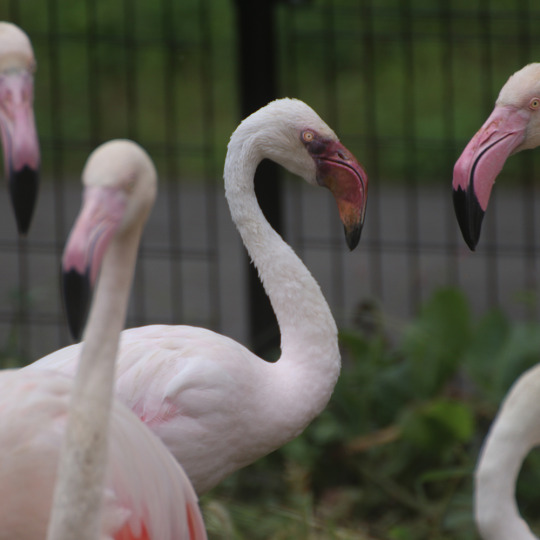
おびただしいヨーロッパフラミンゴの中に一羽だけコフラミンゴがいると聞いて。そんなん全力で探す。
@盛岡市動物公園
It was written that there's a single Lesser Flamingo among the numerous Greater Flamingos. I found him.
@Morioka Zoological Park
#European Greater flamingo#Greater flamingo#Phoenicopterus ruber roseus#Phoenicopterus roseus#Phoenicopterus minor#Lesser Flamingo#bird#flamingo#ヨーロッパフラミンゴ#オオフラミンゴ#コフラミンゴ#盛岡市動物公園
26 notes
·
View notes
Text
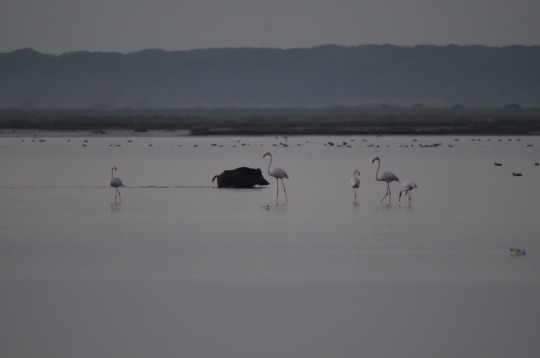
European wild pig Sus scrofa scrofa
With greater flamingo Phoenicopterus roseus
Observed by brunoparisotto, CC BY-NC
#Sus scrofa scrofa#European wild pig#Suidae#pig#non-ungulate#bird#flamingo#Phoenicopterus roseus#greater flamingo#Europe#Italy
56 notes
·
View notes
Text
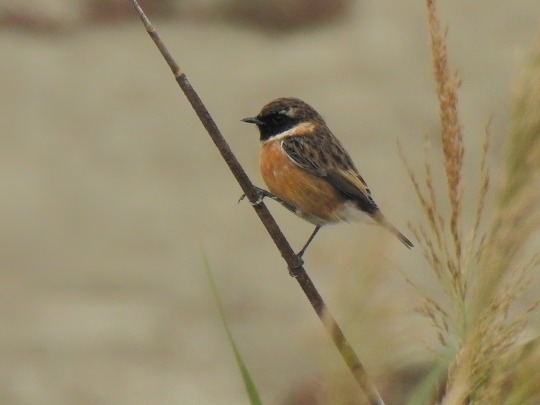
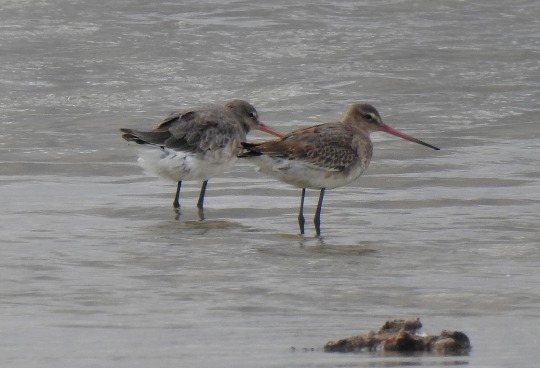

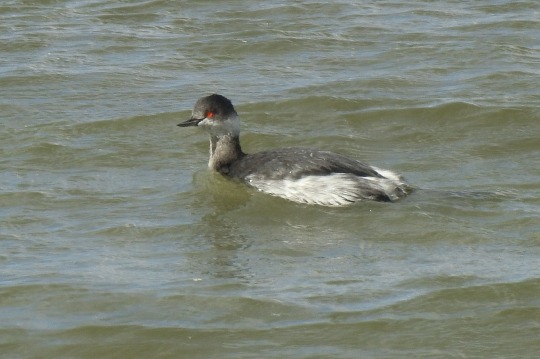
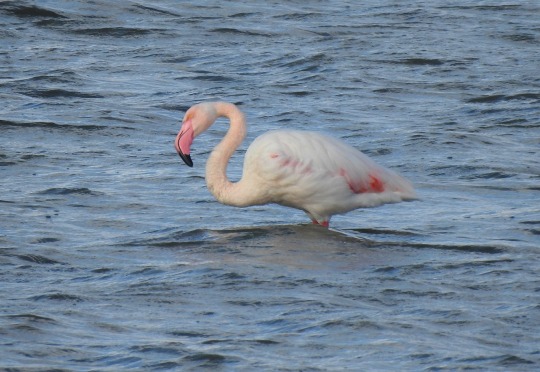
Some cool birds I saw on a uni trip in the Alcazar de San Juan lakes. Definitely the best thing I've ever seen in Ciudad Real. Also it was really cool seeing wild flamingos.
European stonechat (Saxicola rubicola)
Black-tailed godwit (Limosa limosa)
Northern shoveler (Spatula clypeata)
Black-necked grebe (Podiceps nigricollis)
Greater flamingo (Phoenicopterus roseus)

#birds#bird photography#birdwatching#european stonechat#saxicola rubicola#northern shoveler#Spatula clypeata#Black-tailed godwit#limosa limosa#Phoenicopterus roseus#greater flamingo#Black-necked grebe#Podiceps nigricollis#ciudad real
17 notes
·
View notes
Note
I'm going to southern france next month. Any suggestions for common birds to keep an eye out for? Our library system had one book on birds of Europe and it's huge and overwhelming.
Birds of the Camargue
I do not have a way of knowing what birds are common in that region, versus what is occasional, but I can put you in touch with some resources, along with a few of the cooler birds from that region.
(*we messaged earlier about what are of southern France they would be visiting.)
Some good links:
Birds of Camargue - The Birds of Camargue (oiseaux-de-camargue.fr)
Accueil - Bureau des Guides Naturalistes - Site officiel (guide-nature.fr)
Birdwatching in the Camargue (surfbirds.com)
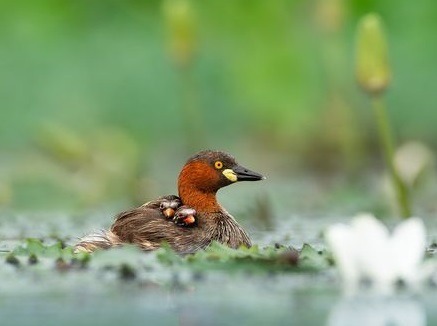
Little Grebes aka Dabchicks (Tachybaptus ruficollis), family Podicipedidae, order Podicipediformes
Photograph by Mainak Halder

Bearded Reedling aka Bearded Tit (Panurus biarmicus), family Panuridae, order Passeriformes
photograph by Carlo Galliani https://www.facebook.com/carlo.galliani.58
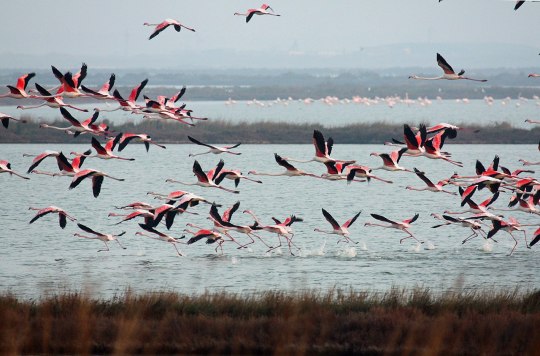
Greater Flamingo (Phoenicopterus roseus), family Phoenicopteridae, order Phoenicopteriformes
photograph by Carlo Pelagalli
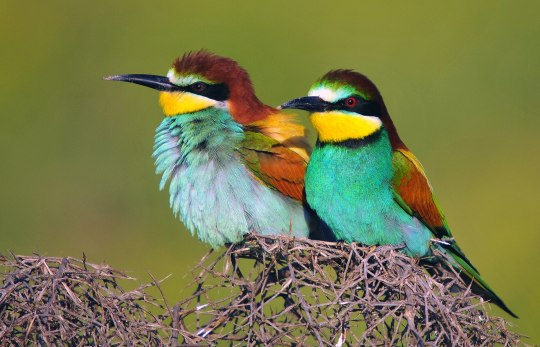
European Bee-eater (Merops apiaster), family Meropidae, order Coraciiformes
photograph by Dûrzan Cîrano
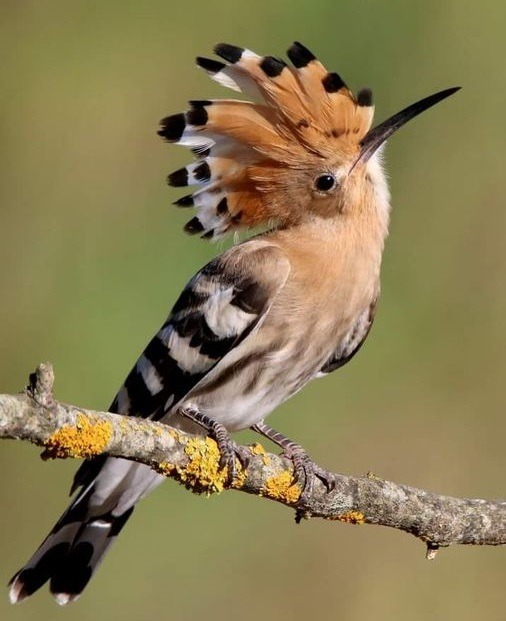
Eurasian Hoopoe (Upupa epops), family Upupidae, order Bucerotiformes
photograph by João Gomes
126 notes
·
View notes
Note
hi! i'm really loving icarus, you're a wonderful writer! but i just had a quick question. i love the flock graphics, and they're super helpful! would it be possible for you to maybe list the species of birds for the main 'characters' of the story as well? you don't have to post example photos or anything crazy, but i think just a list like that would be helpful too. sometimes i forget who has what kind of wings, and i think having a list so i can google image the bird would be great.
if that's not something you want to do or don't have time to do or something, no worries!! i really appreciate you taking the time to write icarus in the first place <3
Oof I might as well do a general guide! I never thought a maxiel wingfic would spawn so many specific wing allocations but here's the general list:
Paddock wings in Icarus:
Current grid:
Daniel Ricciardo - Scarlet Macaw (colourful, nimble flyers)
Max Verstappen - Peregrine Falcon (raw speed, inherited from his mother)
Sergio Perez -Crested Caracara (a type of mexican bird of prey)
Lewis Hamilton - Greater Bird of Paradise (beautiful wing plumes, lovely singer)
George Russell - Blue swallow (beautiful metallic-blue feathers, scream like madmen when they fly)
Carlos Sainz - Spanish Imperial Eagle (white epaulets, very regal)
Charles Leclerc - White Dove (need I say more? Perfect white wings, exploited because they're pretty but so intelligent in pathfinding)
Lando Norris - Lucifer Hummingbird (Small, colourful, likes to hover in place)
Oscar Piastri - Little Lorikeet (One of the smaller types of Australian parrot. Very cute)
Yuki Tsunoda - Japanese Long-tailed tit (Photos should be self explanatory. They fly like ballistic missiles)
Alexander Albon - Crested Fireback (National bird of Thailand. Beautiful dark blue and fiery plumage)
Logan - Blue Jay (Commonly found in Florida. Blue, like Logan's current posting, and his eyes)
Pierre Gasly - Osprey (A bird of prey often found near coasts along the European shoreline, and Pierre is from Normandy)
Esteban Ocon - Black Stork (Tall, gangly, also migrates through France)
Fernando Alonso - Kestrel (a type of small bird of prey, hunts by biding their time and waiting then divebombing)
Lance Stroll - Snowy Owl (Lance is cuddly ok and I didn't want to make him a Canadian goose because that's his dad)
Valtteri Bottas - Bullfinch (Look it up. The picture is self-explanatory. The manliest of men)
Zhou Guanyu - Chinese Red-Crowned Crane (A crowned crane for the champion of the universe, as translates his name)
Kevin Magnussen - Raven (Viking. quoth the raven.)
Nico Hulkenberg - Crow (he keeps coming back. As wily as many of their bird counterparts but has a bad rep for being a bad omen)
Retired drivers or drivers not currently on the grid:
Sebastian Vettel - Swiftlet (Extremely good fliers, reaching up to 160km/h and pulls insane G-forces)
Mick Schumacher - European robin (Very cute. Universally liked. Same wings as his father)
Nico Rosberg - Eurasian Sparrowhawk (a bird of prey that hunts by ambushing before a high-speed, agile chase)
Jenson Button - Northern Harrier (hunts in a high-speed flight close to the ground, exceptionally good listeners)
Mark Webber - Cassowary (look up a photo. Just look at it.)
Kimi Raikkonen - Giant Albatross (King of gives no shits, flies very long distances without a care)
David Coulthard - Bush-Stone Curlew (White trousers!)
Romain Grosjean - Red-tailed Hawk (I chose the bird of prey that could best mesh with the phoenix metaphor)
Antonio Giovannazi - White-spotted Starling (Very pretty plumage)
Daniil Kyvat - Great Bustard (I honestly don't remember why. Distributes in Russia)
Nyck De Vries - Common European Sparrow (Small. Commonly found. Unfortunately often hunted)
Nikita Mazepin - Flamingo (Need I say more)
Sir Jackie Stewart - (Clipped) Merlin Wings (Extremely fast Scottish bird of prey. In-fic, Jackie was one of the generation of drivers that clipped their wings, permanently robbing them of flight)
Team Principals and people in the paddock:
Toto Wolff - Black Swan (self-explanatory)
Christian Horner - Golden Eagle (A bit pompous. Matches his hair)
James Vowles - Magpie (Utterly clever, not from any particular prestige)
Fred Vasseur - Partridge (Affable. Cuddly.)
Guenther Steiner - Shoebill (self-explanatory, look up a photo)
Cyril Abiteboul - Eagle Owl (something about his face is very Eagle Owl)
Micheal Italiano - Kookaburra (laughs when they shouldn't)
Zak Brown - Chicken (self-explanatory. Literally and metaphorically)
Andreas (mclaren) - Common Quail (short lifespan)
Mattia Binotto - Pigeon (wants to be as pretty and loved as Charles. Is a public nuisance instead)
Otmar sznafnauer - Peacock (Struts around, can't really fly)
Resident Bastard:
Jos Verstappen - Cuckoo (Cuckoos are brood parasites, and lay their eggs in nests of birds of other species'. The cuckoo parent therefore does nothing while other birds raise their young)
#I've probably missed a couple minor characters so if anyone has any questions feel free to drop a reply and I'll answer#f1#f1 wingfic#f1 wing au#icarus#my post#writing#fanfic
36 notes
·
View notes
Text
Alrighty and HERE ARE OUR CONTENDERS!!!
Tag for the polls: #bird battle
DISCLAIMER - I wrote the round one blurbs when I was very sick and half awake, so if you see any mistakes PLEASE TELL ME! Nicely, obviously, but I want to make sure they sound good for round 2. Thank you!
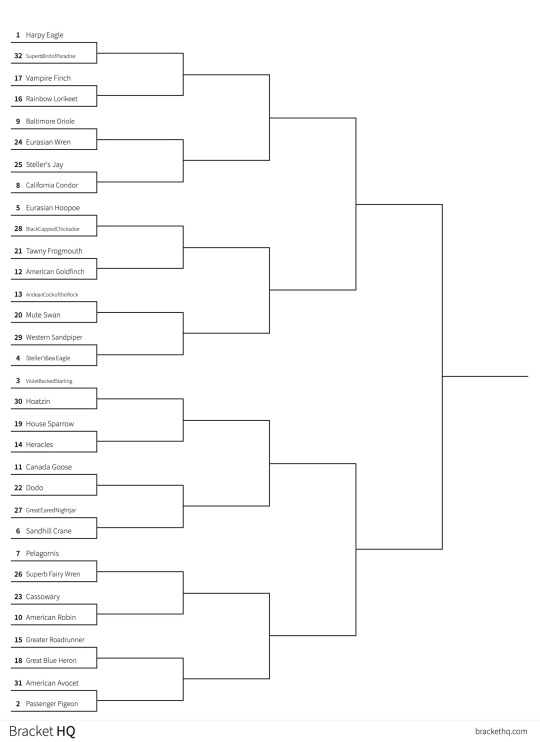

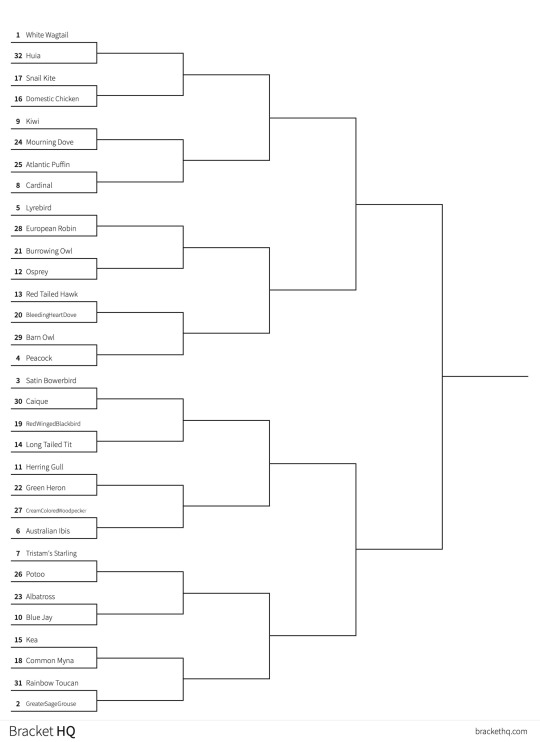

I know there’s a lot of them, but man there’s SO MANY GOOD BIRDS! There were a few times where people didn’t put what specific subspecies for some birds, so sometimes I’d have to choose one. I tried to choose one that represents that bird the best!
I don’t know when the polls will begin, I’m doing some research on the birds so that people can read about them before they vote.
If one of your favs didn’t make it in, don’t worry they’re a winner in my and your heart.
If you are wondering where the Pigeon (Rock Dove) is, THEY ARE THE FINAL CHAMPION! At the end of this bracket, the winner will face off against the mightily popular Rock Dove! Will they be able to beat such a tough challenger? We will see…
Also, a note on how I set this bracket up: I put all the birds in a numbered list and then used a number generator. I think the matchups we got were really interesting.
Full list under the cut
HARPY EAGLE
SUPERB BIRD OF PARADISE
VAMPIRE FINCH
RAINBOW LORIKEET
BALTIMORE ORIOLE
EURASIAN WREN
STELLER'S JAY
CALIFORNIA CONDOR
EURASIAN HOOPOE
BLACK CAPPED CHICKADEE
TAWNY FROGMOUTH
AMERICAN GOLDFINCH
ANDEAN COCK OF THE ROCK
MUTE SWAN
WESTERN SANDPIPER
STELLER'S SEA EAGLE
VIOLET BACKED STARLING
HOATZIN
HOUSE SPARROW
HERACLES
CANADIAN GOOSE
DODO
GREAT EARED NIGHTJAR
SANDHILL CRANE
PELAGORNIS
SUPERB FAIRY WREN
SOUTHERN CASSOWARY
AMERICAN ROBIN
GREATER ROADRUNNER
GREAT BLUE HERON
AMERICAN AVOCET
PASSENGER PIGEON
WALLCREEPER
GREAT TIT
MOA
EASTERN BLUEBIRD
AUSTRALIAN BUSHTURKEY
EMU
MALLARD DUCK
FLAME BOWERBIRD
MANDARIN DUCK
BELTED KINGFISHER
OILBIRD
FAIRY PENGUIN
LESSER FLAMINGO
AUSTRALIAN KESTREL
CARRION CROW
UMBRELLABIRD
LOGGERHEAD SHRIKE
PERUVIAN PELICAN
CALIFORNIA QUAIL
MACGREGORS BOWERBIRD
HARRIS HAWK
COMMON RAVEN
BEARDED VULTURE
PEREGRINE FALCON
ROSY LOVEBIRD
ROSEATTE SPOONBILL
LONG TAILED GRACKLE
AMERICAN WOODCOCK
KAKAPO
BLUE FOOTED BOOBY
RHEA
BEE HUMMINGBIRD
WHITE WAGTAIL
HUIA
SNAIL KITE
DOMESTIC CHICKEN
KIWI
MOURNING DOVE
ATLANTIC PUFFIN
CARDINAL
LYREBIRD
EUROPEAN ROBIN
BURROWING OWL
OSPREY
RED TAILED HAWK
BLEEDING HEART DOVE
BARN OWL
PEACOCK
SATIN BOWERBIRD
CAIQUE
RED WINGED BLACKBIRD
LONG TAILED TIT
HERRING GULL
GREEN HERON
CREAM COLORED WOODPECKER
AUSTRALIAN IBIS
TRISTAM'S STARLING
POTOO
WANDERING ALBATROSS
BLUE JAY
KEA
COMMON MYNA
RAINBOW TOUCAN
GREATER SAGE GROUSE
TURKEY VULTURE
TUFTED TITMOUSE
CRESTED AUKLET
EURASIAN MAGPIE
BUDGIE
SCREECH OWL
WIP-POOR-WILL
SECRETARY BIRD
AUSTRALIAN MAGPIE
CEDAR WAXWING
VICTORIA CROWNED PIGEON
HERMIT THRUSH
COMMON SWIFT
WHITE BELLBIRD
BROWN SKUA
EUROPEAN DIPPER
111 notes
·
View notes
Text
List of Birds organized by Order + locations:
Accipitriformes:
Bearded vulture
California condor
Cooper's hawk
Osprey
Red-shouldered hawk
Steller's sea eagle
Anseriformes:
Bar-headed goose
Barnacle goose
Black swan
Common merganser
Red-breasted goose
Snow goose
Trumpeter swan
Apodiformes:
Common swift
Ruby-throated hummingbird
Bucerotiformes:
Eurasian hoopoe
Cariamiformes:
Red-legged seriema
Casuariiformes:
Emu
Southern cassowary
Cathartiformes:
Black vulture
Turkey vulture
Charadriiformes:
American oystercatcher
Atlantic puffin
Black-headed gull
Black skimmer
Black-tailed godwit
European herring gull
Killdeer
Northern lapwing
Ruddy turnstone
Western sandpiper
Ciconiiformes:
White stork
Columbiformes:
Common wood pigeon
Eurasian collared dove
Luzon bleeding-heart
Nicobar pigeon
Stock dove
Victoria crowned pigeon
Coraciiformes:
Blue-capped kingfisher
Common kingfisher
Cuculiformes:
Asian koel
Greater roadrunner
Yellow-billed cuckoo
Eurypygiformes:
Kagu
Falconiformes:
American kestrel
Common kestrel
Galliformes:
Palawan peacock-pheasant
Plain chachalaca
Scaled quail
Western capercaillie
Gaviiformes:
Common loon
Gruiformes:
American coot
Australasian swamphen/pūkeko
Blue crane
Common moorhen
Sandhill crane
Sora
Whooping crane
Passeriformes:
American bushtit
American robin
Australian raven
Baltimore oriole
Barn swallow
Black-billed magpie
Black-capped chickadee
Black-headed grosbeak
Black-throated sparrow
Blue-headed vireo
Blue jay
Bluethroat
Brown thrasher
California scrub jay
California towhee
Canada warbler
Canyon wren
Cave swallow
Cedar waxwing
Common blackbird
Common chlorospingus
Common raven
Eastern wood pewee
Eurasian blue tit
Eurasian bullfinch
Eurasian golden oriole
Eurasian jay
Eurasian magpie
European robin
Goldcrest
Great-tailed grackle
Great tit
Hooded crow
House sparrow
Indigo bunting
Kirtland's warbler
LeConte's sparrow
Long-tailed tit
Mexican jay
Painted bunting
Phainopepla
Pine siskin
Pin-tailed whydah
Pinyon jay
Pygmy nuthatch
Red winged blackbird
Rook
Saltmarsh sparrow
Satin bowerbird
Spotted towhee
Steller's jay
Tufted titmouse
Wallcreeper
Warbling vireo
Western tanager
White-breasted nuthatch
White-throated dipper
White-throated magpie-jay
Yellow-rumped warbler
Pelecaniformes:
Black-crowned night heron
Brown pelican
Great blue heron
Great egret
Great white pelican
Least bittern
Roseate spoonbill
Shoebill stork
Snowy egret
Phoenicopteriformes:
American flamingo
Chilean flamingo
Piciformes:
Acorn woodpecker
Clark's nutcracker
Great spotted woodpecker
Lesser spotted woodpecker
Lewis's woodpecker
Northern flicker
Pileated woodpecker
Red-bellied woodpecker
Red-headed woodpecker
Podargiformes:
Tawny frogmouth
Podicipediformes:
Pied-billed grebe
Procellariiformes:
Wilson's storm-petrel
Psittaciformes:
Australian king parrot
Chestnut-fronted macaw
Citron-crested cockatoo
Cockatiel
Galah
Gang-gang cockatoo
Pacific parrotlet
Red-masked parakeet
Rose-ringed parakeet
Sulphur-crested cockatoo
Strigiformes:
Barn owl
Barred owl
Eurasian eagle-owl
Suliformes:
Anhinga
Blue-footed booby
Double-crested cormorant
Trogoniformes:
Elegant trogon
Locations:
Africa
America
Antarctica
Asia
Australia
Eurasia
Europe
Oceania
8 notes
·
View notes
Note
YOUR TOP FIVE BIRBS <3
THANK YOU
All types of corvid but especially european magpies (that is me)
Bearded Vulture
Puffins
Greater Flamingo
Potoo
Shout out also to all species of ducks and pigeons, keas, rheas, takahē, starlings, shrikes, roadrunners, beos, the andean cock-of-the-rock, Livingston's turaco, collared redstart, barn owls, peacocks, adelie penguins, cassowary, kookaburra.....
9 notes
·
View notes
Text
🦚Send in a number + Character and I'll draw them in an outfit based on that bird🦚
Allen's Hummingbird
African Crowned Crane
African Emerald Cuckoo
American Goldfinch
Anna's Hummingbird
Asian Emerald Cuckoo
Asian Koel
Atlantic Puffin
Azure Kingfisher
Bald Eagle
Barn Owl
Barn Swallow
Barred Owl
Bat Falcon
Bearded Vulture
Bee Hummingbird
Black Swan
Blue-And-Yellow Macaw
Blue Crowned Pigeon
Blue-Footed Booby
Blue Jay
Bohemian Waxwing
Brahma Chicken
Broad-Billed Hummingbird
Bronze Fallow Cockatie
Canadian Goose
Cassowary
Cardinal
Common Raven
Coua
Dusky Lory
Diederik Cuckoo
Eastern Brown Pelican
Egret
Emerald Starling
Emperor Penguin
Emu
Eurasian Hoopoe
Eurasian Magpie
European Starling
European Turtle Dove
Flamingo
Frigatebird
Fruit Dove
Galah
Gambel's Quail
Golden-Breasted Starling
Golden Pheasant
Gouldian Finch
Grandala
Great Hornbill
Great Horned Owl
Greater Blue-Eared Starling
Green-Legged Partridge
Gurney’s Pitta
Hawaiian Honeycreepers
Hoatzin
Hooded Crow
Horned Sungem
Hyacinth Macaw
Kadaknath
Kakapo
Keel-Billed Toucan
Lilac-Breasted Roller
Long Tailed Tit
Luzon Bleeding-Heart Dove
Mandarin Duck
Mountain Bluebird
Montezuma quail
Mute Swan
Nicobar Pigeon
Northern Oriole
Painted Bunting
Paradise Tanager
Peafowl (peacock/peahen)
Peregrine Falcon
Pileated Woodpecker
Pink Cockatoo
Rainbow Lorikeet
Red Crested Turaco
Red-Necked Tanager
Resplendent Quetzal
Ribbon-Tailed Astrapia
Ruby-Throated Hummingbird
Scarlet Macaw
Secretary Bird
Snowy Owl
Stork-Billed Kingfisher
Sulphur-Crested Cockatoo
Superb Bird-Of-Paradise
Superb Starling
Victoria Crowned Pigeon
Violetear
Violet-Backed Starling
Violet-Green Swallow
Wood Duck
Wilson's Bird-Of-Paradise
Yellow-Crowned Woodpecker
Yellow-Faced Myna
Zanzibar Red Bishop
7 notes
·
View notes
Note
Do yu know what other animals were in ancient egypt? I want my oc to have a unique animal and you seem to know a fair amount

I am a well of ridiculous, hyperspecific, only interesting to some trivia lmao.
I would encourage you not to limit yourself to an entirely unique beast- many deities share sacred animals and are still strong individuals. My mind immediately goes to the huge number of feline deities- lions and lionesses in particular- for an example. Additionally, it's nigh impossible for me (with no academic anthropology/egyptology/historic zoology knowledge) to say for certain that particular animals were present in Kemet when they have no documented deities, mummies, or written mentions. I've had to guess for some, deduce by their present day habitats and more or less "timeline" of their species.
It's also important to keep in mind Kemet had contact with other civilizations in other habitats, meaning they were aware of animals not necessarily native to the area. A perfect example is the Hamadryas baboon- they were Nubian animals, but were sacred to both Thoth and Babi, depicted in art, and many mummies of the species have been recovered. A more surprising example is the Syrian brown bear, which was a rare exotic spectacle for the royal elite. There's also the trouble of many species now being extant from the area, meaning they were there but the local population is now extinct- the African sacred ibis is the example my mind comes to first, the waterfowl no longer present along the Nile.
Coincidentally, I've been compiling a list of animals for my own reference to supply a beast or two for the deities that don't have one in tradition.

Birds
Abdim's Stork
African Darter
African Dwarf Kingfisher
African Grass Owl
African Open-billed Stork
African Pied Wagtail
African Sacred Ibis
Asian Green Bee-Eater
Barbary Falcon
Barbary Partridge
Barn Owl
Barn Swallow
Bearded Vulture
Bennu Heron (likely not an actual animal, the Bennu bird inspired by the Goliath Heron- but felt like including it anyhow)
Black Kite
Black Stork
Black-throated Loon
Black-winged Kite
Brown-necked Raven
Carrion Crow
Cattle Egret
Chukar Partridge
Common Buzzard
Common Cormorant
Common Crane
Common Greenshank
Common House Martin
Common Kestrel
Common Kingfisher
Common Pochard
Common Quail
Common Raven
Common Redshank
Common Redstart
Common Sandpiper
Common Spoonbill
Common Teal
Crab Plover
Crested Plover
Dalmatian Pelican
Demoiselle Crane
Eagle (I'm sure there were some, but I can't find any definitive evidence of species in the ancient Kemetic culture- I would take a guess that the Golden Eage was an infrequent visitor)
Egyptian Plover
Egyptian Vulture
European Roller (considered a pest)
European Turtle-dove
Eurasian Coot
Eurasian Crag Martin
Eurasian Teal
Eurasian Wigeon
Fan-tailed Raven
Ferruginous Duck
Gadwall
Garganey
Glossy Ibis
Golden Oriole
Goliath Heron
Great Bittern
Great Bustard
Great Cormorant
Great Egret
Great Spotted Cuckoo
Great White Pelican
Greater Flamingo (possibly not native)
Green Sandpiper
Grey Heron
Griffon Vulture
Helmeted Guineafowl (not native)
Hermit Ibis
Hobby Falcon
Honey Buzzard
Hooded Crow
Hoopoe
Houbara Bustard
House Crow
House Sparrow (pest, hieroglyph had negative connotation)
Kittliz's Plover
Lanner Falcon
Lappet-faced Vulture
Laughing Dove
Lesser Kestrel
Lesser Pied Kingfisher
Little Bittern
Little Bustard
Little Egret
Little Owl
Long-eared Owl
Long-legged Buzzard
Mallard
Marabou Stork
Marsh Sandpiper
Masked Shrike
Merlin
Mourning Wheatear
Northern Lapwing
Northern Pintail
Northern Shoveler
Ostrich
Pale Crag Martin
Peregrine Falcon
Pied Avocet
Pink-backed Pelican
Purple Gallinule
Purple Heron
Red Kite
Red-backed Shrike
Red-footed Falcon
Red-rumped Wheatear
Reed Cormorant
Ring-necked Dove
Rock Dove
Rook
Ruddy Shelduck
Saddle-bill Stork
Saker Falcon
Sandhill Crane
Sand Martin
Sand Partridge
Short-eared Owl
Spotted Redshank
Sooty Falcon
Squacco Heron
Striated Heron
Swan (not native)
Tawny Owl
Tufted Duck
Western Reef Heron
White-backed Night Heron
White-crowned Wheatear
White Stork
White Wagtail
Wood Sandpiper
Yellow-billed Stork
Mammals
Aardvark (possibly not native)
Aardwolf
Addax Antelope
African Clawless Otter
African Giant Shrew
African Green Monkey (not native)
African Grass Rat
African Leopard
African Striped Weasel
Arabian Oryx
Barbary Deer (not native)
Barbary Lion (now extinct)
Barbary Macaque (not native)
Black Rat
Common Patas Monkey (not native)
Black Rhinoceros
Blanford's Fox
Black Wildebeest
Bubal Hartebeest (now extinct)
Cairo Spiny Mouse
Cape Hare
Caracal
Cheetah
Common Beisa Oryx
Common Genet
Desert Hedgehog
Desert Long-eared Bat
Dorcas Gazelle
Desert Black Cobra
Egyptian Fruit Bat
Egyptian Jackal/African Wolf (originally misidentified, now the African Wolf)
Egyptian Mongoose
Egyptian Pipistrelle
Egyptian Red Fox
Egyptian Slit-faced Bat
Egyptian Tomb Bat
Egyptian Weasel
Egyptian Wild Ass
Fennec Fox
Flower's Shrew
Four-toed Jerboa
Geoffroy's Horseshoe Bat
Gerenuk
Giraffe
Golden Spiny Mouse
Greater Egyptian Jerboa
Greater Mouse-tailed Bat
Greater Red Musk Shrew
Hamadryas Baboon (not native)
Hippopotamus
Honey Badger
House Mouse
Lesser Egyptian Jerboa
Lesser Mouse-tailed Bat
Long-eared Hedgehog
Long-nosed Shrew
North African/Bush Elephant (vilified and driven out by prehistoric Egyptians)
North African Crested Porcupine (not native)
Nubian Ibex (not native)
Olive Baboon (likely not native, sometimes called the Anubis Baboon)
Persian Fallow Deer (not native)
Rhim Gazelle
Rüppell's Fox
Sand Rat
Serval (likely not native, but Ra was depicted as one)
Scimitar Oryx
Soemmerring's Gazelle
Somali Dwarf Shrew
Spotted Hyena
Spotted-necked Otter
Striped Hyena
Syrian Brown Bear (not native)
Wild Boar
White Rhinoceros
Yellow Baboon (not native, species' epithet means 'dog-head' in Greek)
Vervet Monkey
Reptiles
African Chameleon
African Rock Python
Arabian Horned Viper
Desert Horned Viper
Desert Monitor Lizard
Egyptian Cobra
Egyptian Gecko
Egyptian Sand Boa
Egyptian Sand Racer
Egyptian Tortoise
Javelin Sand Boa
Insects/Arachnids/Etc.
Nile Crocodile
Nile Soft-shelled Turtle
Red Spitting Cobra
Saharan Sand Viper
Amphibians
African Common Toad
European Green Toad
Marsh Frog
Mascarene Grass Frog
Nile Delta Toad
Nile Valley Toad
Camel Spider
Banded Garden Spider
Brown Widow Spider
Carpenter Ant
Centipede
Click Beetle
Common Housefly (NOT considered a pest, actually revered as a protector)
Danaid Eggfly
Desert Ant
Desert Locust
Devil's Coach Horse Beetle
Dorippus Tiger Butterfly
Dragonfly
Flea
Fire Ant
Jewel Beetle
Gaudy Commodore Butterfly
Half-edged Wall Jumping Spider
Large Salmon Arab Butterfly
Maggot/Carrion Fly
Migratory Locust
Messor Ant
Millipede
Red-breasted Goose
Mosquito (pest)
Moths in the Saturniidae family
Palestine Yellow Scorpion
Pantropical Jumping Spider
Pharaoh Ant
Plain Tiger Butterfly
Praying Mantis
Scarab Beetle
Sinai Baton Blue Butterfly
Southern White Admiral Butterfly
Scorpions in the Buthidae and Scorpionidae families
Water Scorpion
Fish, Mollusks, etc. (Keep in mind fish were taboo in Kemet)
Abju
African Catfish
African Tigerfish
Bayad Fish
Blacktip Shark
Blue-spotted Stingray
Bolti
Chromis
Cichlid
Cornish Jack
Eel
Flatfish
Gilt-head Bream
Great Barracuda
Leopard Shark
Lepidotus Fish
Loligo Squid
Lungfish
Moon Fish
Mullet
Nile Barb
Nile Bichir
Nile Carp
Nile Mormyrid
Nile Labeo
Nile Perch
Nile Puffer
Parrotfish
Reef Manta Ray
Reef Shark
Sandbar Shark
Sea Snake
Scorpionfish
Spiny Lobster
Sturgeon
Surgeonfish
Swordfish
Thornback Ray
Thresher Shark
Tiger Shark
Tilapia
Triggerfish
Unicorn Fish
Wrasse
Zebra Shark
Domestic Animals
Bean Goose
Brant Goose
Camel (not introduced until Middle/New Kingdom)
Cats (Mau breed)
Chickens (not introduced until New Kingdom era)
Cow/Bull
Dogs (Saluki, Greyhound, Basenji, and Pharaoh Hound breeds)
Donkey
Egyptian Goose
Greater White-fronted Goose
Greylag Goose
Honey Bees
Horse (not introduced until New Kingdom)
Pig
Ram
My sources, if you're interested, are the Wikipedia page for Egyptian wildlife, a few different diving sites about the Mediterranean and Red Sea, a couple books I own on Ancient Egypt that describe the geography of the periods, and this lovely reddit multi-post
Sheep
16 notes
·
View notes
Text
I can. Greater flamingoes are native to the Mediterranean. Going by my field guide for European birds, they don't breed in Croatia specifically, but flamingoes breeding in Italy do forage along the Croatian coast.
@one-time-i-dreamt I was playing a sporcle quiz about Croatia’s native and it showed me this; can you confirm?

1K notes
·
View notes
Text
ComputerwolfUwU’s Other Mr. Men and Little Miss Animals
For @computerwolfartsy
Mr. Greedy - Common Wombat Mr. Sneeze - Hedgehog Mr. Snow - Polar Bear Mr. Topsy-Turvy - Meerkat Mr. Silly - Long-Tailed Macaque Mr. Uppity - Mountain Quail Mr. Daydream - Sheep Mr. Forgetful - Cacomistle Mr. Mean - American Crocodile Mr. Chatterbox - Cockatoo (because Little Miss Chatterbox was a Parakeet) Mr. Muddle - Side-Striped Jackal Mr. Dizzy - Elephant Mr. Impossible - Dolphin Mr. Clumsy - Scottish Wildcat Mr. Rush - Peregrine Falcon Mr. Worry - Least Chipmunk Mr. Nonsense - Chimpanzee Mr. Wrong - Cardinal Mr. Skinny - Whooping Crane Mr. Mischief - Bat-Eared Fox Mr. Clever - Great Horned Owl Mr. Busy - Dromedary Camel Mr. Slow - Tortoise Mr. Brave - Alpine Ibex Mr. Grumble - Cougar Mr. Perfect - Indian Peafowl Mr. Cheerful - Frilled Lizard Mr. Cool - Leopard Mr. Good - White Dove Bird Mr. Nobody - Mimic Glass Lizard Mr. Marvelous - Fancy Rat Mr. Adventure - Wandering Albatross Mr. Calm - Coatimundi Mr. Brilliant - Giraffe Little Miss Neat - Persian Cat Little Miss Tiny - Pygmy Shrew Little Miss Trouble - Dingo Little Miss Shy - European Mink Little Miss Splendid - Greater Flamingo Little Miss Late - Slow Loris Little Miss Scatterbrain - Ocellated Turkey (because Mr. Scatterbrain was a Wild Turkey) Little Miss Greedy - Common Wombat (same as Mr. Greedy) Little Miss Twins - Chinchillas Little Miss Dotty - Eastern Spotted Skunk Little Miss Lucky - Giant Panda Little Miss Star - French Poodle Little Miss Fickle - Duroc Pig Little Miss Contrary - Cape Genet Little Miss Busy - Arabian Horse Little Miss Quick - Greyhound Dog Little Miss Wise - Aardvark Little Miss Tidy - Monarch Butterfly Little Miss Brainy - Crow Bird Little Miss Stubborn - Donkey (because Mr. Stubborn was a Mule) Little Miss Fun - Pomeranian Dog Little Miss Somersault - Kangaroo Little Miss Bad - Wolverine Little Miss Princess - Griffin Little Miss Hug - Koala Little Miss Fabulous - Bird-Of-Paradise Little Miss Sparkle - Firefly Little Miss Inventor - Mongolian Gerbil Little Miss Brave - Gazelle Little Miss Kind - Lesser Bilby Little Miss Energy - Sugar Glider
2 notes
·
View notes
Text
Ultra All Inclusive Nature & Nurture
Azul Beach Resort Montenegro by Karisma enjoys it’s geolocation, the amazing Ulcinj Riviera and outstanding Long Beach, and is a proud host of diverse flora and fauna, some often experienced on the 17 hectares of landscaped gardens and resort property.
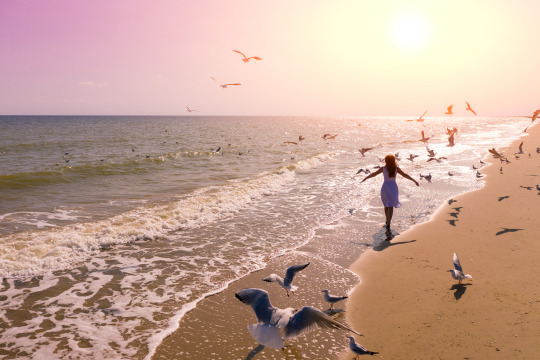
Ulcinj Salina is among the most important bird areas on the Adriatic and Europe as a whole. The area encompassed in the greater region is Ada Bojana Island, Sasko and Skadar Lake, Velipoja in Albania and Velika Plaza/ Long Beach – home to Ultra All-Inclusive Azul Beach Resort Montenegro by Karisma.
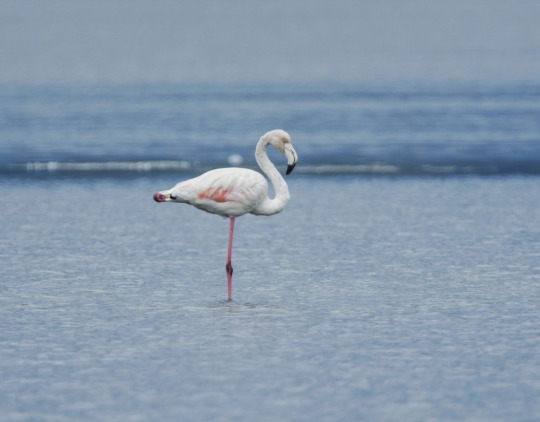
We are excited to be located by the Ulcinj Salina, a unique fauna and flora habitat, and the most important resting, wintering and breeding site for many species of waterbirds along the Adriatic Flyway. Thousands of individual birds and 250 species rely on this area, including the amazing Great Flamingos, Black-winged stilts and Dalmatian Pelicans, as well as being a habitat for many endangered species of fish, amphibians, reptiles and plants. During the transitory phase in springtime there are more than 40,000 migrating birds per day. The nearly 250 registered species make up for 50% of registered species of the European continent, making it one of top places for birdwatching in Europe!
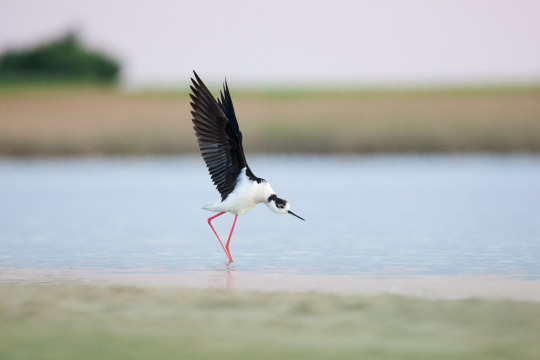
The vegetation of our amazing location is as diverse, currently over 110 plant species have been defined. Additionally, the Montenegrin Olive Route stretching to the Ulcinj Riviera produces also a delicate type of olive oil, indigenous in Southern Montenegro dubbed as ‘yellow yield’, continuing tradition of olive production centuries’ old.
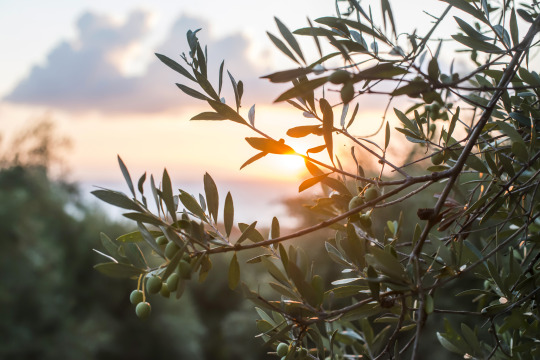
You might notice our enthusiasm in local produce in our cuisine and menus, but you will also definitely meet our chirping cohosts, the swallows. They particularly enjoy visiting your terraces and verandas and our resort paths and corners, but their favorite pastime in our resort is watching you have coffee at the The Lobbyist! As they hunt for insects, ease our days and lull us with their song and friendly nature, we would like to thank you in advance for respecting our surroundings and for supporting us in the love and conservation of this threatened species on the Adriatic. Did you know that swallows are also referred to as the Birds of Freedom? This is because they cannot endure captivity and will only mate in the wild. Unless thoroughly loved and respected. Or so we at Karisma believe!
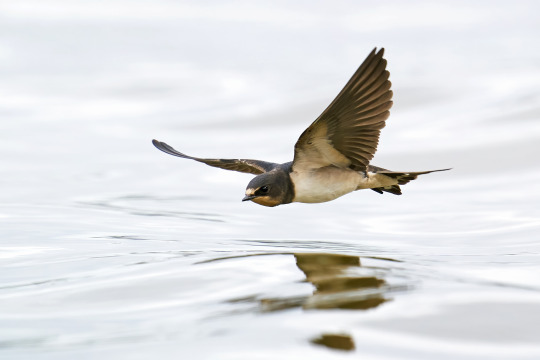
Usually not very calm around human habitation, we are proud that our swallows are very much so due to the respect and love we have between our amazing team and these most amazing birds who fly up to 200 miles a day as their migration takes them south through Europe and across Sahara desert. Most songbirds use a nest for a single season, then build a new one if they survive to breed again. However, studies showed most return to the same colony, and we do so want to welcome our friends again next summer back from South Africa. They are moreover particularly important to our sailors as well as sailors worldwide and all their families, as being land based the swallows are a sign of closeness to the shore and thus home.
Welcome to Azul Beach Resort Montenegro!
www.azulbeachmontenegro.com
Author: #KarismaTeam at #AzulBeachLife #ExperienceMontenegro
#AzulBeachLife#Ulcinj#KarismaAdriatic#AzulBeachMontenegro#karismaexperience#karismahotels#azulbeachresort#KarismaticGeographic#swallows#flamingos#UlcinjSalina#AdriaticSea#AdriaticCoast#olives#oliveroute#Ulqini#Ulqin#UlcinjOliveRoute#blackwingedstilts#pelicans#AdriaticFlyway#LongBeach#VelikaPlaza#ExperienceMontenegro#Montenegro#ultraallinclusive#nature#nurture#ecoconscious
3 notes
·
View notes
Photo

Happy Feathursday!
Happy Feathursday! Enjoy these feathers from 14 different birds. SciArt by J. Terrier from Faune de la Sénégambie, Oiseaux (1884) by Alphonse Trémeau de Rochebrune. View more in Biodiversity Heritage Library with thanks to the Research Library of the Field Museum for digitizing.
1. Unknown (text: Numida cristata)
2. Black Guineafowl (Agelastes niger)
3. Double-spurred Francolin (Francolinus bicalcaratus)
4. White-bellied Bustard (Eupodotis senegalensis)
5. Yellow-billed Stork (Mycteria ibis)
6. African Sacred Ibis (Threskiornis aethiopicus)
7. Demoiselle Crane (Anthopoides virgo)
8. European Golden Plover (Pluvialis apricaria)
9. African Jacana (Actophilomis africanus)
10. White-crested Tiger-heron (Tigriomis leucolopha)
11. Hamerkop (Scopus umbretta)
12. Greater Flamingo (Phoenicopterus roseus)
13. African Pygmy Goose (Nettapus auritus)
14. Arctic Tern (Sterna hirundo)
39 notes
·
View notes
Text
8 DAYS AFRICA VACATION/HOLIDAY
his is the classic Kenyan safari offering you 2 nights at samburu national park with game viewing opportunities, a chance to experience the fabulous flamingos of the lovely Rift Valley Lake Nakuru, the world famous Masai Mara reserve, Lake Naivasha which is a beautiful freshwater lake, fringed by thick papyrus and crown your safari with Amboseli national park with its majestic backdrop of Mt Kilimanjaro promising postcard perfect photos.
You'll be collected from the airport (or hotel).
Accommodation before the tour departs can be arranged for an extra cost.
Day 1: Nairobi / Samburu Game Reserve
Drive north to Samburu on the south bank of the Uaso Nyiro River, downriver from Archer’s Post to arrive at the Lodge for lunch and afternoon game drive. North of the Equator some of the animals and vegetation are a little different from those commonly found south. Elephant, black rhino, lion, buffalo and cheetah and the usual buck and antelopes are common to both north and south of the equator. However unfamiliar animals are the Gravy’s zebra, the reticulated giraffe and the Somali ostrich. There is also the long neck gerenuk, Beisa Oryx, and hunting dog. Crocodiles in the river can be seen from the lodge/tented camp. The vegetation is usually dry grass with a few swampy patches. There is some forest cover along the Uaso Nyiro River and an abundance of doum palms. All meals, Lunch, Dinner and Overnight at the Lodge.
Main Destination: Samburu Game Reserve Accommodation: Samburu Sopa Lodge Standard Lodge located Just Outside Samburu NR Meals & Drinks: Lunch & dinner (Breakfast not included) Drinking water (Other drinks not included)
Day 2: Samburu game reserve
After breakfast, another day in this harshly beautiful terrain where wildlife abounds especially nears the river which is their only source of drinking water. The Uaso Nyiro River flows gently through the dry landscape sustaining life in this harsh land. Shaba National Reserve is where the famous conservationist George Adamson did his research on lions. In the Afternoon you will set out on another game drive and return to the lodge for dinner and overnight.
Main Destination: Samburu Game Reserve Accommodation: Samburu Sopa Lodge Standard Lodge located Just Outside Samburu NR Meals & Drinks: Breakfast, Lunch & dinner (Drinks not included) Drinking water (Other drinks not included)
Day 3: Samburu / Lake Nakuru
After breakfast the tour leaves for Nyahururu (Thompsons Falls) at an altitude of 7,738 feet. The falls are named after the Scots explorer Joseph Thompson who was the first European to discover the falls in 1884. Then comes the descent into the Great Rift Valley to Lake Nakuru National park for lunch at one of the hotels. An afternoon drive in the park to enjoy the sight of pelicans bathing in the fresh water streams which terminate in Lake Nakuru. Since there is no existing drainage, Lake Nakuru is alkaline, the perfect place for flamingos to feed on the blue-green algae. The greater flamingo attains a height of about 4.26 feet its plumage is almost white with a pale pink, black tipped beak. It is the lesser flamingo that has the more exotic color. This Park has a great variety of bird life which includes the Egyptian goose and a variety of ducks that come from Europe to winter, its truly a bird watchers paradise. The park is also a sanctuary for the white rhino and other wild game. Return to the Lodge for Dinner and Overnight.
Main Destination: Lake Nakuru national park Accommodation: Lake Nakuru Lodge Standard Lodge located Inside Lake Nakuru n.p Meals & Drinks: Breakfast, Lunch & dinner (Drinks not included) Drinking water (Other drinks not included)
Day 4: Lake Nakuru / Masai mara
After breakfast, drive to Masai mara game reserve to arrive in time for lunch at the lodge. Masai mara is “Kenya’s finest game reserve. Pass through the lower scenic mau escarpment road into the Rift Valley to the 1792 square, a distance of 275-320kms via Narok town climbing the Hemingway's wall “The Serengeti plains"this park actually forms the northern part of the Serengeti national park in Tanzania. Masai Mara National Reserve to arrive in time for lunch. The afternoon is spent on a game drive in search of the black manned lions which the park is famous, Lion making a kill can be witnessed in the late afternoon or a leopard in a tree enjoying the meal he has dragged up to avoid disturbance and detection. This reserve has hilly savanna, rolling grasslands, gallery forest on the Mara River and its tributaries. Return to the lodge for dinner and overnight.
Main Destination: Masai Mara Game Reserve Accommodation: Masai Mara Sopa Lodge Standard Lodge located just outside Masai Mara Game Reserve Meals & Drinks: Breakfast, Lunch & dinner (Drinks not included) Drinking water (Other drinks not included)
Day 5: Masai mara game reserve
After breakfast, full day of game viewing. Exploration this part of the Northern Serengeti Ecosystem where the great wildebeest migration takes place at the beginning of August. Months before the actual migration the herds ‘assemble’ in Serengeti in readiness for the crossing into Masai Mara. The plain is literally covered with these animals. Grunts and other animal sounds are heard, and territorial fights are commonplace. Africa has a long history of capturing the imagination of travelers, a continent of dramatic contrasts that gives you an unforgettable and remarkable experience whether it’s in an amazement of watching thousands of wild beasts struggling across a rushing river that is littered with crocodiles waiting for their prey, makes the world’s premier wildlife spectacle. Lion making a kill can be witnessed in the late afternoon or a leopard in a tree enjoying the meal he has dragged up to avoid disturbance and detection. All meals and Overnight at the Lodge.
Main Destination: Masai Mara Game Reserve Accommodation: Masai Mara Sopa Lodge Standard Lodge located just outside Masai Mara Game Reserve Meals & Drinks: Breakfast, Lunch & dinner (Drinks not included) Drinking water (Other drinks not included)
Day 6: Masai mara / Lake Naivasha
After breakfast, drive to Lake Naivasha, along the floor of the Rift valley, now with more familiar memories of the landscape; arrive for lunch at the lodge, afternoon proceed on your adventure to various attractive features and places in Lake Naivasha. Much of the lake is surrounded by forests of the yellow barked Acacia Xanthophlea, known as the yellow fever tree. These forests abound with bird life, and Naivasha is known as a world class birding. The waters of the lake draw a great range of game to these shores. Giraffes wander among the acacia, Buffalo wallow in the swamps and Colobus monkeys call from the treetops while the Lakes large hippo population sleeps the day out in the shallows. The region surrounding the Lake is well worth exploring. Optional activities and excursions in Lake Naivasha 1 hour boat ride : USD 20. - Per person 2 hours walking safari on Crescent Island Sanctuary : USD 45.-per person Walking /biking safari at Hells gate national park : USD 45.- per person.
Main Destination: Lake Naivasha Accommodation: Lake Naivasha Sopa Resort Standard Lodge located along the Shores of Lake Naivasha Meals & Drinks: Breakfast, Lunch & dinner (Drinks not included) Drinking water (Other drinks not included)
Day 7: Lake Naivasha / Amboseli
After breakfast, check out and drive to Amboseli national park; the journey continuous south, passing through the Athi Plains where formerly the Burchell's zebra, the Masai giraffe and smaller herbivores roamed about freely. With human encroachment the wildlife is confined to game parks. There is an advantage to this because one has to drive inside a park to be rewarded with the sight of many different species of animals. Amboseli National Park is reached late in the afternoon, for lunch; embark on an afternoon game viewing in the park at the foot of Africa’s highest mountain, Kilimanjaro (19,340 ft). In the late afternoon one is likely to see a lion or cheetah make a kill. Ideal photography opportunities with Mount Kilimanjaro highest mountain in Africa providing a beautiful back drop. Return to the camp for dinner and overnight.
Main Destination: Amboseli national park Accommodation: Amboseli Sopa Resort Standard Lodge located Just outside Amboseli national park Meals & Drinks: Breakfast, Lunch & dinner (Drinks not included) Drinking water (Other drinks not included)
Day 8: Amboseli / Nairobi
Early morning game drive can be taken in Amboseli when Mt. Kilimanjaro appears from its mantle of clouds. Proceed to the area of Lake Amboseli, which is a wide salt pan, consisting of permanent swamps. This area has much game, large and small, high concentration of Elephant, rhino, buffalo, Burchell's zebra, eland, Masai giraffe and small species of the antelope family the common water buck, klipspringer, Grant’s gazelle, impala, topi, and the diminutive duiker among others. Amboseli offers some of the best opportunities to see African animals because its vegetation is sparse due to the long dry months. Amboseli national park is home to wild animals, which include the African elephant, buffalo, impala, lion, cheetah, hyena, giraffes, zebra, and wildebeest among other African animals. There is also a host of Kenya birds, both large and small, to see if you keep your eyes open and stop at every sighting. Drive to Nairobi arriving at the airport in the late afternoon.
Main Destination: Nairobi Accommodation: No Accomodation Provided ( End of Tour) Standard Lodge located Just outside Amboseli national park Meals & Drinks: Breakfast (Lunch, Dinner not included) Drinking water (Other drinks not included)
Additional accommodation can be arranged for an extra cost.
You'll be dropped off at the airport (or hotel).
Lodge / camp name Cost Per Person Sharing
Luxury5 star Rated Lodges/ Camps 2 pax 4 pax 6 pax
Jan - March $1,970 $1,685 $1,590
April- June $1,660 $1,370 $1,270
July-October $2,480 $2,190 $1,940
November- 20.December $1,970 $1,685 $1,590
Standard 4 Star Lodges/ camps 2 Pax 4 Pax 6 Pax
January - March $1,810 $1,520 $1,425
April- June $1,640 $1,370 $1,285
July - October $2,180 $1,800 $1,710
November - 20. December $1,810 $1,520 $1,425
Mid-range 3 star Lodge/camps 2 Pax 4 Pax 6 Pax
January - March $1,640 $1,390 $1,285
April- June $1,480 $1,260 $1,160
July-October $1,970 $1,670 $1,550
November- 20.December $1,640 $1,390 $1,285
( Low Budget / Basic camps) 2 Pax 4 Pax 6 Pax
January - March $1,360 $1,130 $975
April- June $1,330 $1,100 $945
July-October $1,430 $1,190 $995
November- 20.December $1,360 $1,130 $975
Included
Park fees (For non-residents)
All activities (Unless labeled as optional)
All accommodation (Unless listed as upgrade)
A professional driver/guide
All transportation (Unless labeled as optional)
All Taxes/VAT
Round-trip airport transfer
Meals (As specified in the day-by-day section)
Drinking water (On all days)
Excluded
International flights (From/to home)
Additional accommodation before and at the end of the tour
Tips (Tipping guideline US$10.00 pp per day)
Personal items (Souvenirs, travel insurance, visa fees, etc.)
Government imposed increase of taxes and/or park fees
Some meals (As specified in the day-by-day section)

1 note
·
View note
Note
Yo is there a list of characters and their wing types for your Icarus fic ♥️
I'll probably post an appendix with all the wing types on Ao3 later, but here's the list so far, all mentioned in Icarus:
Some of these are related to the driver's country of origin, some are by appearance, and some are by personality and vibes. If anyone has any questions about the wing choices feel free to message me!
2023 grid:
Daniel Ricciardo - Scarlet Macaw
Max Verstappen (and Sophie Kumpen) - Peregrine Falcon
Carlos Sainz - Spanish Imperial Eagle
Charles Leclerc - White Dove
Lando Norris - Lucifer Hummingbird
Oscar Piastri - Little Lorikeet
Yuki Tsunoda - Japanese long-tailed tit
George Russell - Swallow
Lewis Hamilton - Greater bird-of-paradise
Alexander Albon - Crested Fireback
Logan Sargeant - Blue Jay
Pierre Gasly - Osprey
Estaban Ocon - Black Stork
Fernando Alonso - Kestrel
Lance Stroll - Canadian goose
Kevin Magnussen - Raven
Nico Hulkenberg - Crow
Zhou Guanyu - Chinese red-crowned crane
Valtteri Bottas - Bullfinch
Sergio Perez - Petrel
Nyck De Vries - Common European Sparrow
Retired/inactive drivers:
Nico Rosberg - Eurasian Sparrowhawk
Jenson Button - Northern Harrier
Sebastian Vettel - Swiftlet
Mark Webber - Cassowary
Kimi Raikkonen - Giant albatross
Romain Grosjean - Red-tailed hawk
David Coulthard - Bush-stone curlew
Mick (and Michael) Schumacher - European robin
Antonio Giovanazzi - White-spotted starling
Daniil Kyvat - Great Bustard
Nikita Mazepin - Flamingo
Jackie Stewart - Merlin wings (permanently clipped at the final wing joint)
Team Principals and team staff:
Toto Wolff - Black Swan
Christian Horner - Golden Eagle
Cyril Abiteboul - Eagle Owl
Zak Brown - Chicken
Andreas Seidl - Common quail
Guenther Steiner - Shoebill
Mattia Binotto - Pigeon
Fred Vasseur - Partridge
James Vowles - Magpie
Simon Rennie - Cormorant
Michael Italiano - Kookaburra
Otmar Szafnauer - Peacock
Other (brief) mentions:
Susie Wolff - Gannet
Shit but necessary mentions:
Jos Verstappen - Cuckoo
Danica Patrick (barf) - Roseate spoonbill
I'll post a proper appendix to Icarus later on with explanations of the wing choices after each one.
#if my regular readers spot anyone I've missed please do tell me#icarus#f1#f1 wingfic#replies#anon#my post#writing
12 notes
·
View notes